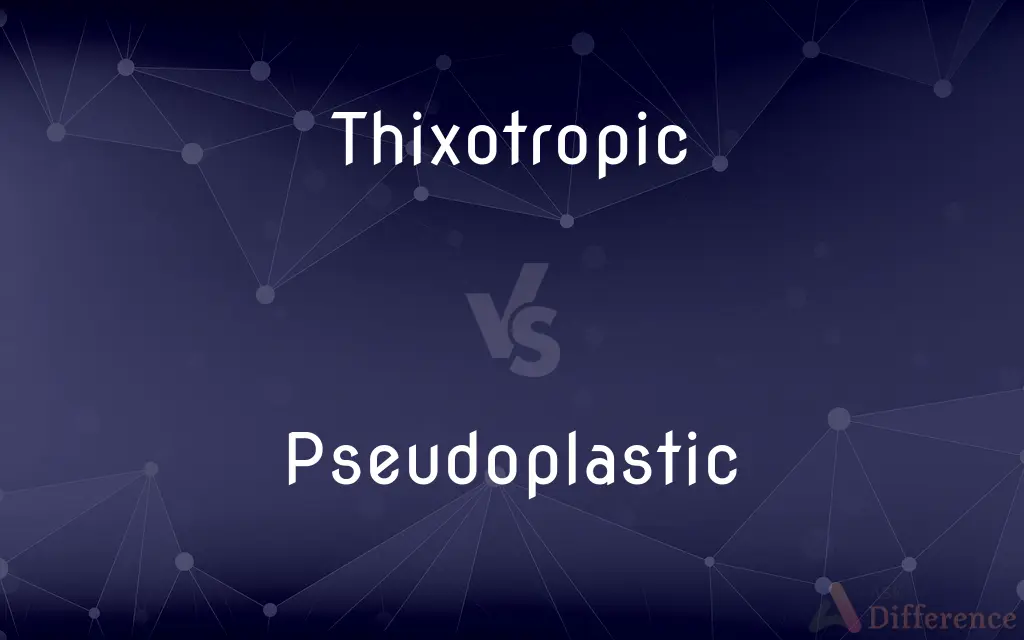Thixotropic vs. Pseudoplastic — What's the Difference?
By Urooj Arif & Fiza Rafique — Updated on March 21, 2024
Thixotropic substances become less viscous over time under constant shear stress, whereas pseudoplastic materials also decrease in viscosity with increasing shear rate but recover immediately once the stress is removed.

Difference Between Thixotropic and Pseudoplastic
Table of Contents
ADVERTISEMENT
Key Differences
Thixotropic substances, such as certain gels and creams, exhibit a decrease in viscosity when subjected to a constant shear stress over time. This property is crucial in applications where a material needs to flow or be spread easily when agitated or stressed but retain its shape or thickness when at rest. Pseudoplastic substances, on the other hand, such as ketchup or blood, also become less viscous as the shear rate increases, but this behavior is not time-dependent. Their viscosity decreases with increased stress but returns to the original state immediately when the stress ceases.
The key distinction between thixotropic and pseudoplastic substances lies in the time dependency of their behavior under shear stress. Thixotropic materials require a certain amount of time under constant stress to exhibit a significant reduction in viscosity, making them ideal for applications where gradual changes in material flow are beneficial. Pseudoplastic materials react immediately to changes in shear stress without a time-dependent component, which is advantageous in situations where quick adjustments to material flow are necessary.
In terms of recovery, thixotropic materials take time to regain their original viscosity once the shear stress is removed, which can be an important feature in processes where the material needs to remain in place after application. Pseudoplastic materials, however, recover their viscosity immediately after the removal of stress, which is useful in applications where rapid return to initial viscosity is required.
The measurement and analysis of thixotropic and pseudoplastic behaviors are essential for understanding material performance in various applications, such as in the formulation of paints, cosmetics, and food products. The thixotropic property is often desirable in materials that need to maintain a certain shape or consistency after application, while pseudoplasticity is sought after in products that need to be easily spread or pumped but resist flowing under their own weight.
Both thixotropic and pseudoplastic materials play crucial roles in industrial and consumer applications, with their unique properties tailored to meet specific requirements. Understanding the differences between these behaviors allows for the optimization of material formulations and the design of products with desired performance characteristics under varying stress conditions.
ADVERTISEMENT
Comparison Chart
Viscosity Change
Decreases over time under constant shear stress.
Decreases immediately with increasing shear rate.
Time Dependency
Yes, viscosity reduction is time-dependent.
No, reacts immediately to shear stress without delay.
Recovery
Takes time to regain original viscosity after stress.
Recovers original viscosity immediately after stress.
Application Examples
Paints, gels, and certain adhesives.
Ketchup, blood, and many polymer solutions.
Ideal Use
Situations requiring gradual flow change or shape retention.
Applications needing easy spread or flow with quick recovery.
Compare with Definitions
Thixotropic
Slowly regains viscosity when stress is removed.
Once applied, thixotropic adhesives retain their shape due to slow viscosity recovery.
Pseudoplastic
Viscosity decreases with increasing shear rate.
Pseudoplastic fluids like ketchup flow easily when squeezed.
Thixotropic
Exhibits a gradual response to applied stress.
Thixotropic fluids start thick but become fluid under sustained stress.
Pseudoplastic
Regains original viscosity once stress ceases.
Once the squeezing stops, ketchup stops flowing and retains its shape.
Thixotropic
Viscosity decreases over time under constant shear.
A thixotropic gel becomes easier to spread with continuous stirring.
Pseudoplastic
Thins out quickly under stress.
Pseudoplastic inks flow under pen pressure, then thicken on paper.
Thixotropic
Used in formulations needing controlled flow.
Thixotropic sealants are easy to apply yet maintain robustness.
Pseudoplastic
Common in food, cosmetics, and inks.
Pseudoplastic creams spread smoothly and return to original consistency.
Thixotropic
Ideal for materials requiring shape retention.
Thixotropic paints stay where applied without dripping.
Pseudoplastic
Ideal for products requiring ease of flow and stability.
Pseudoplastic lubricants provide smooth application and stable coating.
Thixotropic
The property exhibited by certain gels of becoming fluid when stirred or shaken and returning to the semisolid state upon standing.
Pseudoplastic
(physics) Whose viscosity decreases as shear stress increases (as with paint and ketchup, for example).
Thixotropic
Becoming a fluid when agitated but solid or semi-solid when allowed to stand.
Pseudoplastic
Any material that exhibits pseudoplasticity
Common Curiosities
Why is thixotropy important in paints?
Thixotropy in paints allows for easy application (low viscosity when stirred or applied) and prevents dripping (increased viscosity when still).
xWhat is thixotropy?
Thixotropy is a property of some fluids that become less viscous over time when a constant shear stress is applied.
What does pseudoplastic mean?
Pseudoplastic refers to fluids that decrease in viscosity with an increase in shear rate, without the viscosity change being dependent on time.
How do thixotropic and pseudoplastic substances differ?
The primary difference lies in time dependency; thixotropic substances change viscosity over time under stress, while pseudoplastic substances change immediately with shear rate.
Can a substance be both thixotropic and pseudoplastic?
Yes, a substance can exhibit both properties, showing immediate shear thinning and further viscosity reduction over time.
What makes ketchup a pseudoplastic fluid?
Ketchup flows easily when squeezed (high shear rate) but thickens when left undisturbed, demonstrating pseudoplastic behavior.
What role does pseudoplasticity play in food products?
Pseudoplasticity ensures food products like sauces or dressings pour easily yet retain their shape on a plate.
How do pseudoplastic fluids behave under no stress?
Under no stress, pseudoplastic fluids return to their original, more viscous state.
How is thixotropy measured?
Thixotropy is measured by observing the decrease in viscosity of a substance over time under constant shear stress.
Can thixotropic substances be used in 3D printing?
Yes, thixotropic materials are advantageous in 3D printing for their ability to flow under pressure and then maintain shape.
How does temperature affect thixotropic behavior?
Temperature can affect the rate at which a thixotropic substance recovers its viscosity; higher temperatures typically reduce recovery time.
What is a practical example of a thixotropic substance in everyday life?
Toothpaste is a common thixotropic substance; it flows easily from the tube when squeezed but holds its shape on the brush.
Are all gels thixotropic?
Not all gels are thixotropic; the property depends on the gel's composition and structure.
Share Your Discovery

Previous Comparison
Viceregent vs. Vicegerent
Next Comparison
GDP vs. GNPAuthor Spotlight
Written by
Urooj ArifUrooj is a skilled content writer at Ask Difference, known for her exceptional ability to simplify complex topics into engaging and informative content. With a passion for research and a flair for clear, concise writing, she consistently delivers articles that resonate with our diverse audience.
Co-written by
Fiza RafiqueFiza Rafique is a skilled content writer at AskDifference.com, where she meticulously refines and enhances written pieces. Drawing from her vast editorial expertise, Fiza ensures clarity, accuracy, and precision in every article. Passionate about language, she continually seeks to elevate the quality of content for readers worldwide.













































